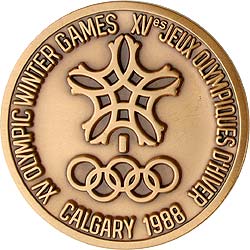|

|

|
|
|
|
|
|
Medal Information |
| |
Summer Olympics
1896 Athens, Greece
1900 Paris, France
1904 St.Louis, USA
1906 Athens, Greece
1908 London, England
1912 Stockholm, Sweeden
1920 Antwerp, Belgium
1924 Paris, France
1928 Amsterdam, Netherlands
1932 Los Angeles, USA
1936 Berlin, Germany
1948 London, England
1952 Helsinki, Finland
1956 Melbourne, Australia
1960 Rome, Italy
1964 Tokyo, Japan
1968 Mexico City, Mexico
1972 Munich, Germany
1976 Montreal, Canada
1980 Moscow, USSR
1984 Los Angeles, USA
1988 Seoul, Korea
1992 Barcelona, Spain
1996 Atlanta, USA
2000 Sydney, Australia
Winter Olympics
1924 Chamonix, France
1928 St.Moritz, Switzerland
1932 Lake Placid, USA
1936 Garmisch, Germany
1948 St.Moritz, Switzerland
1952 Oslo, Norway
1956 Cortina, Italy
1960 Squaw Valley, USA
1964 Innsbruck, Austria
1968 Grenoble, France
1972 Sapporo, Japan
1976 Innsbruck, Austria
1980 Lake Placid, USA
1984 Sarajevo, Yugoslavia
1988 Calgary, Canada
1992 Albertville, France
1994 Lillehammer, Norway
1998 Nagano, Japan
2002 Salt Lake City, USA
| |
|
|
|
|
1988 WINTER OLYMPIAD
CALGARY (ALB), CANADA
|

Hold mouse over image to view reverse.
If the image does not load, simply hit refresh.
|
Composition: | Bronze |
Shape: | Round |
Diameter: | 64 mm |
Thickness: | 7 mm |
Weight: | 133 grams |
Edge: | Plain |
Mintage: | 10,000 |
Designer: | Cornelius Martens |
|
|
| DESCRIPTION |
The Calgary Olympic snowflake emblem and the Olympic rings are centered on the obverse surrounded by the English and French legend XV OLYMPIC WINTER GAMES XVes JEUX OLYMPIQUES DíHIVER CALGARY 1988. The reverse depicts the Saddledome Stadium, City of Calgary and the Rocky Mountains with the Olympic Torch along the left edge and the Olympic motto CITIUS ALTIUS FORTIUS along the lower periphery. The medals were presented in a brown velvet case with a white cardboard sleeve.
|
THE GAMES |
For the first time, the Winter Olympics were extended to 16 days, including three weekends. The Alpine events were expanded from three to five with the inclusion of the super giant slalom and the Alpine combined. Team events were added in Nordic combined and ski jumping. Jumper Matti Nykšnen took advantage of this new program to win three gold medals. The speed skating races were held indoors and Yvonne van Gennip surprised the favorites with three victories. Christa Rothenburger won the 1000m. Seven months later she earned a silver medal in cycling to become the only athlete ever to win medals in the Winter and Summer Olympics in the same year. Figure skater Katarina Witt defended her Olympic title, while on the menís side, Brian Boitano edged Canadaís Brian Orser in an extremely close decision. Charismatic skier Alberto Tomba made his first Olympic appearance, winning both the giant slalom and the slalom.
|
|
|
| |
